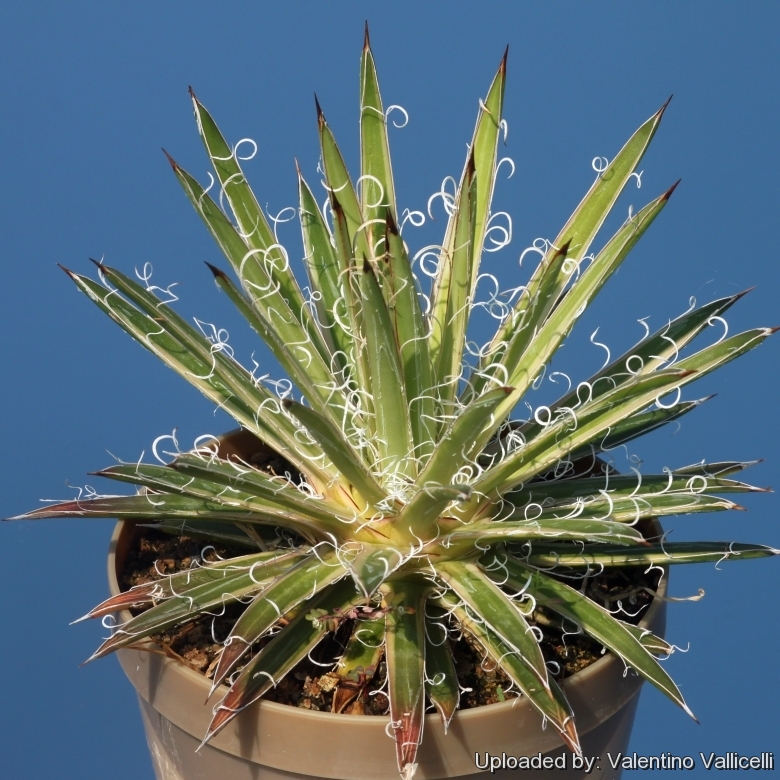
Agave х leopoldii cv. Hammer Time Photo by: Valentino Vallicelli
Origin and Habitat: Garden origin.
Synonyms:
See all synonyms of Agave x leopoldii
back
Accepted name in llifle Database:Agave х leopoldii hort. ex G.NicholsonGard. Chron. 1912 (ex Dict. Gard. Suppl., 82,1900)
Cultivars
(1):
back
Common Names include:
ENGLISH: Hammer Time Agave, Variegated Thread Agave
Description: This is a sport selected by Gary Hammer from a normal Agave x leopoldii discovered in Mexico, with its spiky leaves covered with numerous curling threads. But the leaves are slightly elongated with a golden stripe down their edges. It forms a 20 cm x 30 cm wide clump of 7 mm wide bayonet-like, dark green leaves, each edged with a chartreuse border, then covered in curly white hairs. This cultivar does offset only occasionally, unlike both of its parents.
Subspecies, varieties, forms and cultivars of plants belonging to the Agave filifera group
 Agave filifera Salm-Dyck: Forms tight rosettes of narrow, hairy, stiff dull-green leaves with very sharp terminal spines.
Agave filifera Salm-Dyck: Forms tight rosettes of narrow, hairy, stiff dull-green leaves with very sharp terminal spines. Agave filifera f. cristata: This is one the very few known crested agaves, it forms a strange fan shaped, wavy rosette.
Agave filifera f. cristata: This is one the very few known crested agaves, it forms a strange fan shaped, wavy rosette. Agave filifera subs. schidigera (Lem.) B.Ullrich: Small or medium sized plant that forms stemless rosette to 60 to 90. It is decorated with thin white curly marginal fibres spreading in all directions which sometimes are very dense.
Agave filifera subs. schidigera (Lem.) B.Ullrich: Small or medium sized plant that forms stemless rosette to 60 to 90. It is decorated with thin white curly marginal fibres spreading in all directions which sometimes are very dense. Agave filifera subs. schidigera f. compacta hort.: Very compact, small, symmetrical plant, growing to 20-30 cm wide and 20-25 cm tall. Leaves decorated with thin white curly marginal fibres and with very ornamental white bud imprints.
Agave filifera subs. schidigera f. compacta hort.: Very compact, small, symmetrical plant, growing to 20-30 cm wide and 20-25 cm tall. Leaves decorated with thin white curly marginal fibres and with very ornamental white bud imprints. Agave filifera subs. schidigera cv. Shira Ito No Hoi: Rosette is composed of dark green leaves, each highlighted by a creamy-white border and curly white hairs.
Agave filifera subs. schidigera cv. Shira Ito No Hoi: Rosette is composed of dark green leaves, each highlighted by a creamy-white border and curly white hairs. Agave х leopoldii hort. ex G.Nicholson: Miniature hybrid species (A. filifera x A.filifera var. schidigiera) that has lots of fibres peeling off its short, very narrow leaves, and lots of suckers.
Agave х leopoldii hort. ex G.Nicholson: Miniature hybrid species (A. filifera x A.filifera var. schidigiera) that has lots of fibres peeling off its short, very narrow leaves, and lots of suckers. Agave х leopoldii cv. Hammer Time: The leaves are slightly elongated with a golden stripe down their edges.
Agave х leopoldii cv. Hammer Time: The leaves are slightly elongated with a golden stripe down their edges.
 Agave х leopoldii cv. Hammer Time Photo by: Valentino Vallicelli
Agave х leopoldii cv. Hammer Time Photo by: Valentino Vallicelli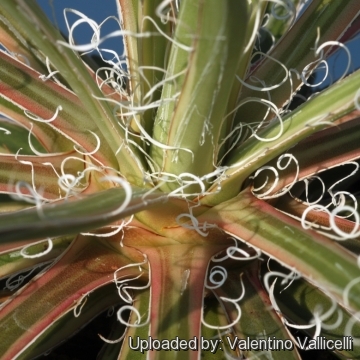 Agave х leopoldii cv. Hammer Time Photo by: Valentino Vallicelli
Agave х leopoldii cv. Hammer Time Photo by: Valentino Vallicelli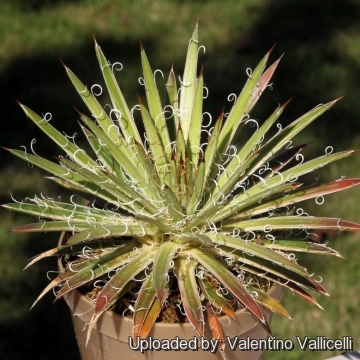 Agave х leopoldii cv. Hammer Time Photo by: Valentino Vallicelli
Agave х leopoldii cv. Hammer Time Photo by: Valentino Vallicelli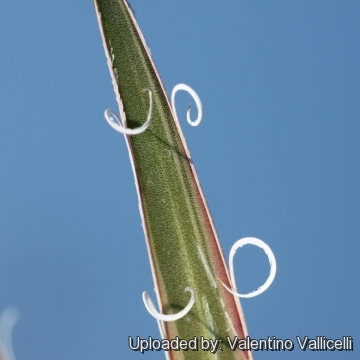 Agave х leopoldii cv. Hammer Time Photo by: Valentino Vallicelli
Agave х leopoldii cv. Hammer Time Photo by: Valentino Vallicelli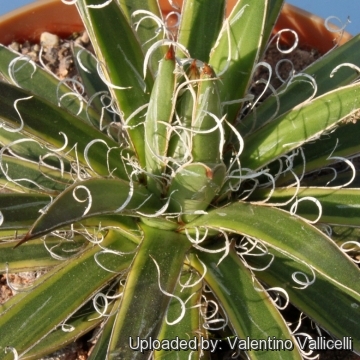 Agave х leopoldii cv. Hammer Time Photo by: Valentino Vallicelli
Agave х leopoldii cv. Hammer Time Photo by: Valentino Vallicelli Agave х leopoldii cv. Hammer Time Photo by: Valentino Vallicelli
Agave х leopoldii cv. Hammer Time Photo by: Valentino Vallicelli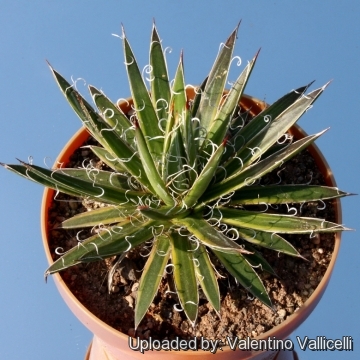 - This sport selected by Gary Hammer takes a favorite old cultivar and gives it a new dimension. Photo by: Valentino Vallicelli
- This sport selected by Gary Hammer takes a favorite old cultivar and gives it a new dimension. Photo by: Valentino VallicelliSend a photo of this plant.The gallery now contains thousands of pictures, however it is possible to do even more. We are, of course, seeking photos of species not yet shown in the gallery but not only that, we are also looking for better pictures than those already present.
Read More... Cultivation and Propagation: It is an easy-to-grow plant often grown as a houseplant.
Growth rate: Plants have a moderate growth rate and form clumps given the best conditions.
Soil: They are tolerant of most soils, but do best in very well-drained, sandy or gravely soil. As ornamental they are also grown in containers where they stay much smaller than their outdoor brethren. In pots they need a very porous mix soil (e.g. 2 parts peat moss to 1 part loam to 1 part of pumice).
Exposure: They do well in full sun or a lightly shaded area with afternoon shade. Plants cultivated outdoors are drought tolerant and takes blasting heat and full sun.
Repotting: Use pot with good drainage.
Watering: It grows fairly fast in summer if provided with copious water but allows to dry thoroughly before watering again. During the winter months, one should only water enough to keep the leaves from shriveling. Avoid waterlogged conditions.
Fertilization: They grows quickly if kept well nourished with a slow release fertilizer specifically formulated for cactus and succulents applied once or twice a year in the spring and summer (poor in nitrogen), including all micro nutrients and trace elements.
Hardiness: It is theoretically hardy to -7° C, particularly when dry. Keep it in a cool area in winter and put it out on the balcony or patio in summer. It is damaged from early morning overhead watering in the winter. The water froze resulting in pockmarks on the leaves.
Scenography: It is quite versatile. Because of its symmetrical form and relatively small size, this plant is very attractive when grown in pots. Plants can be grouped together or planted among boulders in a rock or cactus garden. It is great in small pots or nestled into a rock crevice. They work well with perennials.
Traditional uses: The sap of is fermented to make a light alcoholic Mexican drink called 'pulque'. Rope, food, soap and other products are also made from the fibers and pulp.
Warning: It is armed with sharp spines.
Propagation: By micro-propagation or suckers which often are found growing around the base of the plant. Remove the basal suckers (if available) in spring or summer and let the cuttings dry for a few days before inserting in compost or by seed.

















